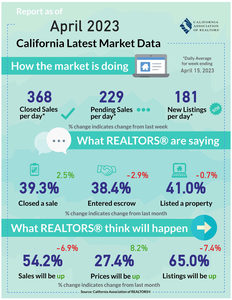 April 17, 2023 – Economic data released last week showed that the U.S. economy is losing momentum as the lagged effects of monetary policy tightening slow growth as intended. Retail sales and Inflation posted its second-straight monthly decline. However, prices remain elevated for core goods and services which will likely push the Fed to hike rates at their May meeting one last time by another 25 basis points. Consumers adjusted their expectations around inflation and although still relatively pessimistic overall, their long-term sentiment remains stable. Californians will continue to face inventory challenge besides in 2023, as fewer REALTORS® are listing properties ahead of the usual spring home buying season.
April 17, 2023 – Economic data released last week showed that the U.S. economy is losing momentum as the lagged effects of monetary policy tightening slow growth as intended. Retail sales and Inflation posted its second-straight monthly decline. However, prices remain elevated for core goods and services which will likely push the Fed to hike rates at their May meeting one last time by another 25 basis points. Consumers adjusted their expectations around inflation and although still relatively pessimistic overall, their long-term sentiment remains stable. Californians will continue to face inventory challenge besides in 2023, as fewer REALTORS® are listing properties ahead of the usual spring home buying season.
Inventory might get worse before it gets better according to REALTORS®: The California Association of REALTORS®’ (C.A.R.) monthly member survey revealed that inventory could pose a challenge ahead of the spring home buying season. The percentage of REALTORS® with listing appointments dropped for the second consecutive month, moving in the opposite direction than usual this time of the year. With less listing appointments, less properties are consequently being listed for sale as evident in the drop-off of REALTORS® reporting listing a property in April. After trending up in the first quarter of the year, the share of respondents indicating having listed a property fell to 18.3%. What is more, they became more pessimistic about listings going up as the share dropped for the second consecutive month. Unfortunately, part of it seems to be reluctance from sellers to list as the share of those holding back from selling jumped to the second highest level on record since the inception of the survey began nearly two years ago.
 Housing affordability for all Californians deteriorates: Housing affordability deteriorated in 2022 for all California ethnic home-buying groups. Home prices soared to record highs last year and interest rates jumped to levels not seen in more than a decade. About one in five of all Californians earned enough income to support the purchase of an $822,320 statewide median-priced home in 2022, down from just over one in four in 2021. By ethnic group, about one-fourth of White California households and a little over one in 10 Black and Hispanic/Latino California households could afford the same median-priced home, while 31% of Asians could buy a median-priced home. The significant difference in housing affordability for Black and Hispanic/Latino households illustrates the homeownership gap and wealth disparity for communities of color, which could worsen as the economy slows and rates remain elevated in 2023.
Housing affordability for all Californians deteriorates: Housing affordability deteriorated in 2022 for all California ethnic home-buying groups. Home prices soared to record highs last year and interest rates jumped to levels not seen in more than a decade. About one in five of all Californians earned enough income to support the purchase of an $822,320 statewide median-priced home in 2022, down from just over one in four in 2021. By ethnic group, about one-fourth of White California households and a little over one in 10 Black and Hispanic/Latino California households could afford the same median-priced home, while 31% of Asians could buy a median-priced home. The significant difference in housing affordability for Black and Hispanic/Latino households illustrates the homeownership gap and wealth disparity for communities of color, which could worsen as the economy slows and rates remain elevated in 2023.
Consumer prices continue cooling but remain elevated: The March report for Consumer Price Index (CPI) showed prices rose by the smallest amount in nine months, but excluding food and energy (core CPI), inflation remains stubbornly high. While the headline CPI slowed to 5% over the same month of last year, core CPI advanced 0.4% in March and pushed up the year-over-year rate to 5.6%. The core CPI has been above 5% for 16 consecutive months, which is more than double the Fed’s target rate and will likely press for them to enact one more rate hike at their upcoming meeting. Looking ahead, many signs like normalization of inventories, scaling back in manufacturing, rolling over of shelter costs, and slower wage growth, all point to less upward pressure on consumer prices.
Retail sales slip again after unusual surge at start of the year: Consumer spending lost momentum over the course of the first quarter, with retail sales falling for a second consecutive month in March. Even with a 1.0% month-to-month drop, spending remains nearly 2% ahead of where it was back in December and close to 3% ahead of the same month of last year. This means, that consumers continued spending at an elevated level. However, the unusual surge in spending seen in January appears to be reversing and with broad-based weakness observed in the latest retail sales report, consumer spending appears to be gradually losing momentum. Furthermore, the elevated cost of borrowing is starting to also weigh on consumers’ decision to purchase big ticket items.
Consumer sentiment is hanging in there: The University of Michigan’s headline index measuring how Americans feel about their own finances as well as the broader economy inched up to 63.5 in April, up from 62.0 in March. Consumers have been broadly pessimistic since last summer when the index dropped to a record low of 50, largely due to high inflation. However, as inflation has gradually eased, both the current and future conditions components of the index improved. Despite short-term inflation expectations (one-year ahead) unexpectedly jumping a full percentage point to 4.6%, suggesting that consumers expect inflation to persist a little while longer, long-term expectations (5-10 years ahead) held steady at 2.9% for the fifth consecutive month.


